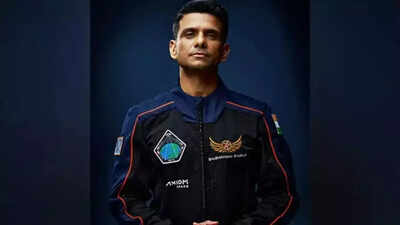Shubhanshu Shukla, currently aboard the International Space Station (ISS) as part of the Axiom-4 (Ax-4) mission, is scheduled to interact with students and scientists at the Indian Space Research Organisation (ISRO) on Friday, July 4th.

This unique opportunity is made possible through the Amateur Radio on the International Space Station (ARISS) program, designed to foster interest in STEM education by connecting students with astronauts in orbit. The interaction will be facilitated via a telebridge at the U R Rao Satellite Centre in Bengaluru. Shukla is part of a 14-day scientific expedition with three other astronauts as part of the Axiom-4 mission.
The ARISS program facilitates this live conversation between Shukla and participants in India. The U R Rao Satellite Centre (URSC) in Bengaluru will host the telebridge station, with communication relayed through the K6DUE ground station. According to reports, the session is scheduled for 3:47 PM IST (10:17 UTC) on Friday. This initiative serves as a vital link between space exploration and education.
Ham radio, also known as amateur radio, is a licensed communication system using radio frequencies allocated for non-commercial purposes. It's favored by enthusiasts and often used during emergencies. In space missions, it offers a reliable communication method, providing a direct line between astronauts and students or amateur operators on Earth, adding a personal element to science education.
While aboard the ISS, Shukla is involved in several key experiments:
Researchers are studying microalgae for their potential as a sustainable and nutrient-rich food source for astronauts. They also play a crucial role in oxygen recycling and waste management. Shukla is monitoring microalgae growth through high-resolution photography. Understanding how microgravity affects algae growth is crucial for developing closed-loop life-support systems, essential for future missions to the Moon, Mars, and beyond.
This project utilizes virtual reality headsets to assess cognitive performance in microgravity. Astronauts engage in attention-based tasks while their brain activity is monitored using functional near-infrared spectroscopy (fNIRS). The data helps scientists understand the effects of space travel on mental acuity, motor function, and memory. This is vital for deep space exploration, where astronauts must perform critical tasks under pressure in confined environments.
This research aims to integrate biometric data with AI-driven mission analytics to track the impact of space on cardiovascular health and balance. By utilizing real-time data analysis and predictive models, this project could transform in-flight medical monitoring and potentially enable remote diagnostic devices for use in rural or emergency areas on Earth. This highlights the potential for medical innovation through space research.
Newer articles
 Greg Chappell: Rishabh Pant is Revolutionizing Cricket with Unconventional Batting Style
Greg Chappell: Rishabh Pant is Revolutionizing Cricket with Unconventional Batting Style
 Earth's Spin Accelerates: Scientists Predict Possible Negative Leap Second by 2029
Earth's Spin Accelerates: Scientists Predict Possible Negative Leap Second by 2029
 Samsung Galaxy A35 5G and A55 5G: Official Pricing and Availability Announced
Samsung Galaxy A35 5G and A55 5G: Official Pricing and Availability Announced
 3 Secrets to a Longer, Healthier Life: Lessons From Japan's Longevity Village
3 Secrets to a Longer, Healthier Life: Lessons From Japan's Longevity Village
 Silent Signals: Heed These Early Heart Attack Warning Signs
Silent Signals: Heed These Early Heart Attack Warning Signs
 Prediabetes Warning: 5 Subtle Signs Your Body Could Be Signaling High Blood Sugar
Prediabetes Warning: 5 Subtle Signs Your Body Could Be Signaling High Blood Sugar
 Gujarat Cricket Association Set to Launch New T20 League, Aiming to Boost Local Talent
Gujarat Cricket Association Set to Launch New T20 League, Aiming to Boost Local Talent
 Raducanu Shuts Down Alcaraz Dating Rumors, Confirms US Open Mixed Doubles Pairing
Raducanu Shuts Down Alcaraz Dating Rumors, Confirms US Open Mixed Doubles Pairing
 'The Traitors' Star Apoorva Mukhija Accuses Sudhanshu Pandey of Misogyny and Abusive Language After On-Screen Criticism
'The Traitors' Star Apoorva Mukhija Accuses Sudhanshu Pandey of Misogyny and Abusive Language After On-Screen Criticism
 Prasidh Krishna Vows to Sharpen Bowling Accuracy and Cut Run Rate in Upcoming Tests
Alternatively (shorter):
Prasidh Krishna Targets Length Improvement, Lower Economy After Costly Outing
Prasidh Krishna Vows to Sharpen Bowling Accuracy and Cut Run Rate in Upcoming Tests
Alternatively (shorter):
Prasidh Krishna Targets Length Improvement, Lower Economy After Costly Outing